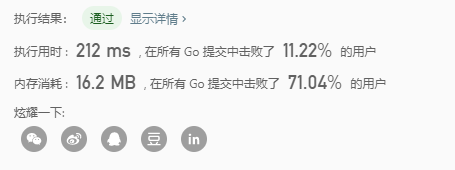146. LRU缓存机制
运用你所掌握的数据结构,设计和实现一个 LRU (最近最少使用) 缓存机制。它应该支持以下操作: 获取数据 get 和 写入数据 put 。
获取数据 get(key) - 如果密钥 (key) 存在于缓存中,则获取密钥的值(总是正数),否则返回 -1。
写入数据 put(key, value) - 如果密钥不存在,则写入其数据值。当缓存容量达到上限时,它应该在写入新数据之前删除最近最少使用的数据值,从而为新的数据值留出空间。
进阶:
你是否可以在 O(1) 时间复杂度内完成这两种操作?
示例:
LRUCache cache = new LRUCache( 2 /* 缓存容量 */ );
cache.put(1, 1);
cache.put(2, 2);
cache.get(1); // 返回 1
cache.put(3, 3); // 该操作会使得密钥 2 作废
cache.get(2); // 返回 -1 (未找到)
cache.put(4, 4); // 该操作会使得密钥 1 作废
cache.get(1); // 返回 -1 (未找到)
cache.get(3); // 返回 3
cache.get(4); // 返回 4
我的解答
最近学了一下Go,Go的解答不多,我来整一个。
很多人都是通过双向链表实现的,我的思路是用map保存键值对,用slice来保存LRU队列。
type LRUCache struct {
capacity int
record []int
cacheMap map[int]int
}
func Constructor(capacity int) LRUCache {
return LRUCache{capacity:capacity,cacheMap:make(map[int]int)}
}
func (this *LRUCache) Get(key int) int {
val,ok:=this.cacheMap[key]
if ok{//存在
for i,v:=range this.record{
if v==key{
if i==this.capacity-1{
this.record=this.record[:i]
}else{
this.record=append(this.record[:i],this.record[i+1:]...)
}
}
}
this.record=append(this.record,key)
return val
}else{//不存在
return -1
}
}
func (this *LRUCache) Put(key int, value int) {
_,ok:=this.cacheMap[key]
if ok{
this.cacheMap[key]=value
for i,v:=range this.record{
if v==key{
if i==this.capacity-1{
this.record=this.record[:i]
}else{
this.record=append(this.record[:i],this.record[i+1:]...)
}
}
}
this.record = append(this.record, key)
return
}
if len(this.record)==this.capacity{
delete(this.cacheMap,this.record[0])
this.record=this.record[1:]
}
this.record = append(this.record, key)
this.cacheMap[key]=value
}
代码有些啰嗦,尤其是删除record元素的部分,可以进一步优化。
